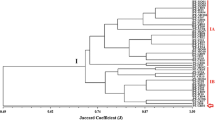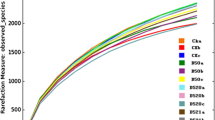Abstract
Soil was sampled to a distance of 2.5 mm beneath a root mat of oilseed rape (Brassica napus) in a model rhizosphere system. DNA was extracted and the 16S rDNA amplified, cloned and sequenced. Phylogenetic analysis of these sequences with those held on-line, revealed that 37% of the clones fell within the Holophaga / Acidobacterium phylum, 17% were within the proteobacteria, 14% of the clones were close relatives of Bacillus megaterium and 5% were related to Verrucomicrobium spinosum. An additional eleven clones (21%) could not be assigned to any known phylum and may represent novel bacterial lineages. This study highlights the diverse nature of rhizosphere soils and reinforces the role that molecular approaches play in unravelling such diversity.
Similar content being viewed by others
References
Altschul SF, Gish W, Miller W, Myers EW & Lipman DL (1990) Basic local alignment search tool. J. Mol. Biol. 215: 403–410
Bazzar FA (1996) Plants in Changing Environments. Cambridge University Press, Cambridge
Bond PL, Hugenholtz P, Keller J & Blackall LL (1995) Bacterial community structures of phosphate-removing and nonphosphate-removing activated sludges from sequencing batch reactors. Appl. and Environ. Microbiol. 61: 1910–1916
Borneman J, Skroch PW, O'Sullivan KM, Palus JÁ, Rumjanek NG, Jansen JL, Nienhuis J & Triplett EW (1996). Molecular microbial diversity of an agricultural soil in Wisconsin. Appl. Environ. Microbiol. 62: 1935–1943
Borneman J & Triplett EW (1997) Molecular microbial diversity in soils from Eastern Amazonia: Evidence for unusual microorganisms and microbial population shifts associated with deforestation. Appl. Environ. Microbiol. 63: 2647–2653
Brosius J, Palmer ML, Kennedy PJ & Noller HF (1978) Complete nucleotide sequence of a 16S ribosomal gene from Escherichia coli. Proc. of the Nat. Acad. of Sci. USA 75: 4801–4805
Brown ME (1975) Rhizosphere micro-organisms: opportunists, bandits or benefactors. In: Soil Microbiology (pp 21–38) Walker & Butterworths. London and Boston
Campbell R & Greaves MP (1990) Anatomy and community structure of the rhizosphere. In: Lynch J (Ed) The Rhizosphere (pp 11–34) John Wiley & Sons. Essex
Edwards U, Rogal T, Blocker H, Emde M & Bottger EC, (1989) Isolation and direct nucleotide determination of entire genes characterization of a gene coding for 16S ribosomal RNA. Nucleic Acids Res. 17: 7843–7853
Ellis RJ, Thompson IP & Bailey MJ (1995) Metabolic profiling as a means to characterizing plant-associated microbial communities. FEMS Microbiol. Ecol. 16: 9–18
Embley TM (1991) The linear PCR reaction: a simple and robust method for sequencing amplified rRNA genes. Lett. Appl. Microbiol. 13: 171–174
Emmerson D & Moyer CL (1997) Isolation and characterization of novel iron-oxidizing bacteria that grow at circumneutral pH. Appl. Environ. Microbiol. 63: 4784–4792
Felsenstein J (1985) Confidence limits on phylogenies an approach using the bootstrap. Evolution 39: 783–791
Felske A, Rheims H, Wolterink A, Stackebrandt E & Akkermans ADL (1997) Ribosome analysis reveals prominent activity of an uncultured member of the class Actinobacteria in grassland soils. Microbiol. 143: 2983–2989
Felske A, Wolterink A, van Lis R & Akkermans ADL (1998) Phylogeny of the main bacterial 16S rRNA sequences in a Drentse grassland soils (The Netherlands). Appl. Environ. Microbiol. 54: 871–879
Gahoonia TS & Nielsen NE (1991) A method to study rhizosphere processes in thin soil layers of different proximity to roots. Plant Soil 135: 143–146
Galtier N & Gouy N (1995) Inferring phylogenies from sequences of unequal base composition. Proc. of the Nat. Acad. of Sci. USA 92: 11317–11321
Goldenberger D & Altwegg M (1995) Eubacterial PCR: contamination of DNA in primer preparations and its elimination by UV light. J. Microbiol. Methods 21: 27–32
Head IM, Saunders JR & Pickup RW (1998) Microbial evolution diversity and ecology: A decade of ribosomal RNA analysis of uncultivated microorganisms. Microbial Ecol. 35: 1–21
Hiraishi A, Kishimoto N, Kosako Y, Wakao N & Tano T (1995) Phylogenetic position of the menaquinone containing acidophilic chemo-organotroph Acidobacterium capsulatum. FEMS Microbiol. Lett. 132: 91–94
Hugenholtz P, Pitulle C, Herschberger KL & Pace NR (1998) Novel division level bacterial diversity in a Yellowstone hot spring. J. Bacteriol. 180: 366–376.
Katznelson H, Lochhead AG & Timonin MI (1948) Soil microorganisms and the rhizosphere. Botanical Rev. 15: 543–587
Kuske CR, Barns SM, & Busch JD (1997) Diverse uncultivated bacterial groups from soils of the arid southwestern United States that are present in many geographic regions. Appl. Environ. Microbiol. 63: 3614–3621
Lane DJ, Pace B, Olsen GJ, Stahl DA, Sogin ML & Pace NR (1985) Rapid determination of 16S ribosomal RNA sequences for phylogenetic analyses. Proc. of the Nat. Acad. of Sci. USA 82: 6955–6959
Liesack W & Stackebrandt E (1992) Occurrence of novel groups of the domain bacteria as revealed by analysis of genetic ma21 terial isolated from an Australian terrestrial environment. Appl. Environ. Microbiol. 174: 5072–5078
Liesack W, Bak F, Kreft JU & Stackebrandt E (1994) Holophaga foetida gen-nov sp-nov A new homoacteogenic bacterium degrading methoxylated aromatic compounds. Archi. Microbiol. 162: 85–90
Lonergan DJ, Jenter HL, Coates JD, Phillips EJP, Schmidt T & Lovley DR (1996) Phylogenetic analysis of dissimilatory Fe(III)-reducing bacteria. J. Bacteriol. 178: 2402–2408
Ludwig W, Bauer SH, Bauer M, Held I, Kirchof G, Huber I, Spring S, Hartmann A & Schleifer KH (1997) Detection and in situ identification of representaives of a widely distributed new bacterial phylum. FEMS Microbiol. Lett. 153: 181–190
Maidak BL, Larsen N, McCaughey MJ, Overbeek R, Olsen GJ, Fogel K, Blandy J & Woese CR (1994) The Ribosomal Database Project. Nucleic Acids Res. 22: 3485–3487
Marilley L, Vogt G, Blanc M & Aragano M (1998) Bacterial diversity in the bulk soil and rhizosphere fractions of Lolium perenne and Trifolium repens as revealed by PCR restriction analysis of 16S rDNA. Plant Soil 198: 219–224
Marrilley L & Aragno M (1999) Phylogenetic diversity of bacterial communities differing in degree of proximity of Lolium perenne and Trifolium repens roots. Appl. Soil Ecol. 13:127–136
Mitsui H, Gorlach K, Lee H-J, Hattori R & Hattori T (1997) Incubation time and media requirements of culturable bacteria from different phylogenetic groups. J. Microbiol. Methods 30: 103–110
Nusslein K & Tiedje JM (1998) Charcterisation of the dominant and rare members of a young Hawaiian soil with small-subunit ribosomal DNA amplified from DNA fractionated on the basis of its guanine and cytosine composition. Appl. Environ. Microbiol. 64: 1283–1289
Ogram A, Sayler GS & Barkay T (1987) The extraction and purification of microbial DNA from sediments. J. Microbiol. Methods 7: 57–66
Petrova MA, Moyer CL & Tiedje JM (1997) Microbial community structure and diversity of ancient Siberian permafrost sediments. In: Abstracts of the 97th General Meeting of the American Society for Microbiology 1997. Amer. Soc. Microbiol. Washington DC
Rappe MS, Kemp PF & Giovannoni SJ (1997) Phylogenetic diversity of marine coastal picoplankton 16S rRNA genes cloned from the continental shelf off Cape Hatteras, North Carolina. Limnol. Oceanography 42: 811–826
Rheims H, Sproeer C, Rainey FA & Stackebrandt E (1996) Molecular biological evidence for the occurrence of uncultured members of the actinomycete line of descent in different environments and geographical locations. Microbiol. 142: 2863–2870.
Saitou N & Nei M (1987) The neighbour joining method: a new method for constructing phylogenetic trees. Mol. Biol. Evol. 6: 514–525
Smalla K, Cresswell N, Mendonca-Hagler LC, Wolters A & van Elsas JD (1993) Rapid DNA extraction protocol from soil for polymerase chain reaction-mediated amplification. J. Appl. Bacteriol. 74: 78–85
Stackebrandt E, Liesack W & Goebel BM (1993) Bacterial diversity in a soil sample from a subtropical Australian environment as determined by 16S rDNA analysis. FASEB J. 7: 232–236
Stackebrandt E & Goebel BM (1994) A place for DNA-DNA reassociation and 16S ribosomal RNA sequence analysis in the present species definition in bacteriology. Int. J. Syst. Bacteriol. 44: 846–840
Stahl DA, Flesher B, Mansfield HR & Montgomery L (1988) Use of phylogenetically based probes for studies of ruminant ecology. Appl. Environ. Microbiol. 54: 1079–1084
Steffan RJ, Goksoyr J, Bej AK & Atlas RM (1988) Recovery of DNA from soils and sediments. Appl. Environ. Microbiol. 54: 2908–2915
Thomson JD, Higgins GD & Gibson TJ (1994) CLUSTAL W: Improving the sensitivity of progressive multiple sequence alignment through sequence weighting positions-specific gap penalties and weight matrix choice. Nucleic Acids Res. 22: 4673–4680
Tsai Y-L & Olson BH (1991) Rapid method for direct extraction of DNA from soil and sediments. Appl. Environ. Microbiol. 57: 1070–1074
Van de Peer Y & De Wachter R (1993) TREECON: A software package for the construction and drawing of evolutionary trees. J. Mol. Evolution 30: 463–476
Wagner A, Blackstone N, Cartwright P, Dick M, Misof B, Snow P, Wagner GP, Bartels J, Murtha M & Pendelton J (1994) Surveys of gene families using polymerase chain reaction: PCR selection and PCR drift. Syst. Biol. 43: 250–261
Ward-Rainey N, Rainey FA, Schlesner H & Stackebandt E (1995) Assignment of hitherto unidentified 16S rDNA species to the main line of descent within the domain Bacteria. Microbiol. 141: 3247–3250
Author information
Authors and Affiliations
Corresponding author
Rights and permissions
About this article
Cite this article
Macrae, A., Rimmer, D.L. & O'Donnell, A.G. Novel bacterial diversity recovered from the rhizosphere of oilseed rape (Brassica napus) determined by the analysis of 16S ribosomal DNA. Antonie Van Leeuwenhoek 78, 13–21 (2000). https://doi.org/10.1023/A:1002745312030
Issue Date:
DOI: https://doi.org/10.1023/A:1002745312030




